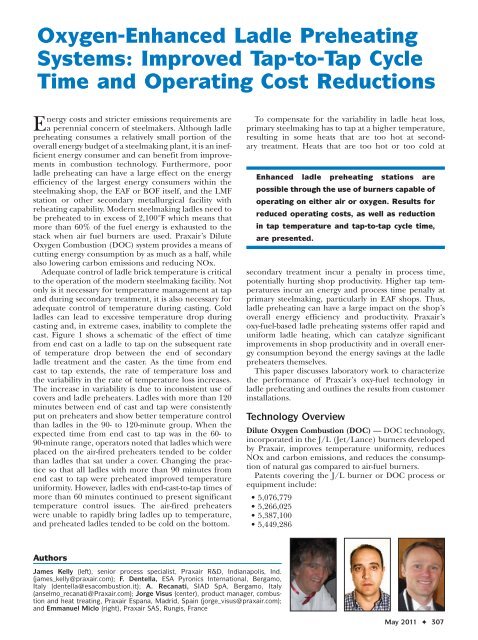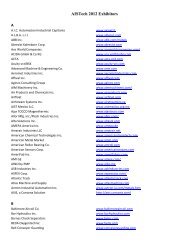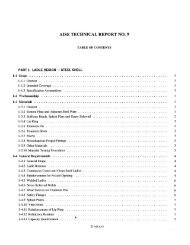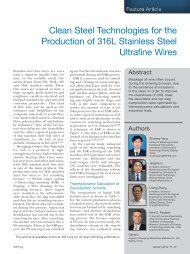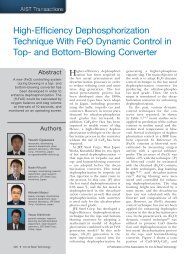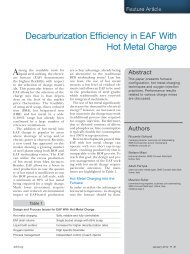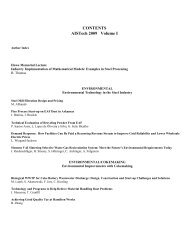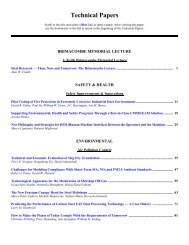Oxygen-Enhanced Ladle Preheating Systems: Improved Tap-to-Tap ...
Oxygen-Enhanced Ladle Preheating Systems: Improved Tap-to-Tap ...
Oxygen-Enhanced Ladle Preheating Systems: Improved Tap-to-Tap ...
Create successful ePaper yourself
Turn your PDF publications into a flip-book with our unique Google optimized e-Paper software.
<strong>Oxygen</strong>-<strong>Enhanced</strong> <strong>Ladle</strong> <strong>Preheating</strong><br />
<strong>Systems</strong>: <strong>Improved</strong> <strong>Tap</strong>-<strong>to</strong>-<strong>Tap</strong> Cycle<br />
Time and Operating Cost Reductions<br />
Energy costs and stricter emissions requirements are<br />
a perennial concern of steelmakers. Although ladle<br />
preheating consumes a relatively small portion of the<br />
overall energy budget of a steelmaking plant, it is an inefficient<br />
energy consumer and can benefit from improvements<br />
in combustion technology. Furthermore, poor<br />
ladle preheating can have a large effect on the energy<br />
efficiency of the largest energy consumers within the<br />
steelmaking shop, the EAF or BOF itself, and the LMF<br />
station or other secondary metallurgical facility with<br />
reheating capability. Modern steelmaking ladles need <strong>to</strong><br />
be preheated <strong>to</strong> in excess of 2,100°F which means that<br />
more than 60% of the fuel energy is exhausted <strong>to</strong> the<br />
stack when air fuel burners are used. Praxair’s Dilute<br />
<strong>Oxygen</strong> Combustion (DOC) system provides a means of<br />
cutting energy consumption by as much as a half, while<br />
also lowering carbon emissions and reducing NOx.<br />
Adequate control of ladle brick temperature is critical<br />
<strong>to</strong> the operation of the modern steelmaking facility. Not<br />
only is it necessary for temperature management at tap<br />
and during secondary treatment, it is also necessary for<br />
adequate control of temperature during casting. Cold<br />
ladles can lead <strong>to</strong> excessive temperature drop during<br />
casting and, in extreme cases, inability <strong>to</strong> complete the<br />
cast. Figure 1 shows a schematic of the effect of time<br />
from end cast on a ladle <strong>to</strong> tap on the subsequent rate<br />
of temperature drop between the end of secondary<br />
ladle treatment and the caster. As the time from end<br />
cast <strong>to</strong> tap extends, the rate of temperature loss and<br />
the variability in the rate of temperature loss increases.<br />
The increase in variability is due <strong>to</strong> inconsistent use of<br />
covers and ladle preheaters. <strong>Ladle</strong>s with more than 120<br />
minutes between end of cast and tap were consistently<br />
put on preheaters and show better temperature control<br />
than ladles in the 90- <strong>to</strong> 120-minute group. When the<br />
expected time from end cast <strong>to</strong> tap was in the 60- <strong>to</strong><br />
90-minute range, opera<strong>to</strong>rs noted that ladles which were<br />
placed on the air-fired preheaters tended <strong>to</strong> be colder<br />
than ladles that sat under a cover. Changing the practice<br />
so that all ladles with more than 90 minutes from<br />
end cast <strong>to</strong> tap were preheated improved temperature<br />
uniformity. However, ladles with end-cast-<strong>to</strong>-tap times of<br />
more than 60 minutes continued <strong>to</strong> present significant<br />
temperature control issues. The air-fired preheaters<br />
were unable <strong>to</strong> rapidly bring ladles up <strong>to</strong> temperature,<br />
and preheated ladles tended <strong>to</strong> be cold on the bot<strong>to</strong>m.<br />
Authors<br />
To compensate for the variability in ladle heat loss,<br />
primary steelmaking has <strong>to</strong> tap at a higher temperature,<br />
resulting in some heats that are <strong>to</strong>o hot at secondary<br />
treatment. Heats that are <strong>to</strong>o hot or <strong>to</strong>o cold at<br />
<strong>Enhanced</strong> ladle preheating stations are<br />
possible through the use of burners capable of<br />
operating on either air or oxygen. Results for<br />
reduced operating costs, as well as reduction<br />
in tap temperature and tap-<strong>to</strong>-tap cycle time,<br />
are presented.<br />
secondary treatment incur a penalty in process time,<br />
potentially hurting shop productivity. Higher tap temperatures<br />
incur an energy and process time penalty at<br />
primary steelmaking, particularly in EAF shops. Thus,<br />
ladle preheating can have a large impact on the shop’s<br />
overall energy efficiency and productivity. Praxair’s<br />
oxy-fuel-based ladle preheating systems offer rapid and<br />
uniform ladle heating, which can catalyze significant<br />
improvements in shop productivity and in overall energy<br />
consumption beyond the energy savings at the ladle<br />
preheaters themselves.<br />
This paper discusses labora<strong>to</strong>ry work <strong>to</strong> characterize<br />
the performance of Praxair’s oxy-fuel technology in<br />
ladle preheating and outlines the results from cus<strong>to</strong>mer<br />
installations.<br />
Technology Overview<br />
Dilute <strong>Oxygen</strong> Combustion (DOC) — DOC technology,<br />
incorporated in the J/L (Jet/Lance) burners developed<br />
by Praxair, improves temperature uniformity, reduces<br />
NOx and carbon emissions, and reduces the consumption<br />
of natural gas compared <strong>to</strong> air-fuel burners.<br />
Patents covering the J/L burner or DOC process or<br />
equipment include:<br />
• 5,076,779<br />
• 5,266,025<br />
• 5,387,100<br />
• 5,449,286<br />
James Kelly (left), senior process specialist, Praxair R&D, Indianapolis, Ind.<br />
(james_kelly@praxair.com); F. Dentella, ESA Pyronics International, Bergamo,<br />
Italy (dentella@esacombustion.it); A. Recanati, SIAD SpA, Bergamo, Italy<br />
(anselmo_recanati@Praxair.com); Jorge Visus (center), product manager, combustion<br />
and heat treating, Praxair Espana, Madrid, Spain (jorge_visus@praxair.com);<br />
and Emmanuel Miclo (right), Praxair SAS, Rungis, France<br />
May 2011 ✦ 307
Figure 1<br />
Effect of end-cast-<strong>to</strong>-tap time on the rate of temperature loss between<br />
the end of secondary processing and casting.<br />
Figure 2<br />
Comparison of the firing rate and temperature versus time for an airfired<br />
and a DOC-fired preheater heating a cold ladle <strong>to</strong> 2,200°F.<br />
Table 1<br />
Summary Statistics From <strong>Ladle</strong> Preheater Comparison<br />
308 ✦ Iron & Steel Technology<br />
DOC<br />
Units Air-fired burner Improvement<br />
Setpoint °F 2,200 2,200 —<br />
Average Fce Temp °F 2,224 2,311 —<br />
Cycle average Fire rate mmBTU/hr 2.85 1.44 50%<br />
Time <strong>to</strong> T min 170 70 59%<br />
NOx lbs/mmBTU 0.073 0.044 40%<br />
NOx lbs/hr 0.21 0.063 70%<br />
• 5,601,425<br />
• 5,755,818<br />
• 5,924,858<br />
• 6,007,326<br />
• 6,394,790<br />
In Dilute <strong>Oxygen</strong> Combustion, the fuel gas<br />
and oxygen are injected separately via highvelocity<br />
jets, creating rapid mixing of the fuel<br />
and oxidant with the hot furnace gases. This<br />
mixing and dilution produces a thermally uniform<br />
heat release with low peak flame temperatures.<br />
The uniform heat release results in more<br />
even temperature distribution throughout the<br />
furnace. The low flame temperatures are key <strong>to</strong><br />
inhibiting the production of thermal NOx.<br />
DOC Concept —<br />
• Separate fuel and oxygen injection at high<br />
velocity.<br />
• Rapid dilution of fuel and oxygen with<br />
furnace gases.<br />
• Diffuse flame results in very uniform heating.<br />
• Low peak flame temperature minimizes<br />
NOx production.<br />
The J-burner portion of the J/L burner consists<br />
of a fuel injection assembly retained within<br />
a concentric oxygen tube. The design of the<br />
J-burner makes use of Praxair’s Coherent Jet<br />
(CoJet ® ) technology <strong>to</strong> delay mixing of the fuel<br />
gas and oxygen. This permits the J-burner <strong>to</strong> be<br />
recessed within the burner refrac<strong>to</strong>ry block for<br />
protection from heat, without risk of damage<br />
due <strong>to</strong> combustion within the recess cavity. The<br />
burner’s fuel assembly is tipped with a fieldreplaceable<br />
nozzle, thereby permitting adjustment<br />
of flame characteristics. The J-burner<br />
includes a spark igniter and UV flame sensor<br />
for self-ignition and flame safety requirements.<br />
The lance portion of the burner is used <strong>to</strong><br />
inject oxygen whenever the furnace is above the<br />
fuel au<strong>to</strong>-ignition temperature. It is separated<br />
from the jet by several inches in order <strong>to</strong> entrain<br />
furnace gases and prevent mixing of<br />
the oxygen and fuel close <strong>to</strong> the burner,<br />
thereby delaying combustion. This<br />
allows the oxygen <strong>to</strong> become “diluted”<br />
with the furnace gases and results in a<br />
much lower flame temperature. Since<br />
combustion takes place throughout the<br />
furnace chamber instead of directly at<br />
the burner, a more diffuse flame is produced<br />
instead of a point heat source,<br />
resulting in more even distribution of<br />
energy throughout the furnace.<br />
Key Burner Characteristics —<br />
• Field-replaceable nozzles —<br />
allows different velocities <strong>to</strong> be
selected. This allows luminosity, burner<br />
momentum, flame intensity, flame length<br />
and heat flux profile <strong>to</strong> be controlled for<br />
each application.<br />
• Includes au<strong>to</strong>matic spark ignition system<br />
and provisions for UV flame detec<strong>to</strong>r for use<br />
with flame safety.<br />
• Burner capacities of 6–9 mmBtu/hr.<br />
• Low maintenance.<br />
The characteristics of DOC technology are presented<br />
in greater detail elsewhere. 1<br />
Labora<strong>to</strong>ry Measurements<br />
To characterize the performance of DOC technology<br />
in a ladle preheating-type application,<br />
the ladle preheating process was simulated in<br />
the labora<strong>to</strong>ry. An existing high-temperature<br />
furnace was modified <strong>to</strong> simulate a ladle with<br />
a cross-sectional area of 1,600 inches and depth of 91<br />
inches. The furnace was lined with 8.75 inches of highalumina<br />
refrac<strong>to</strong>ry. The air firing condition was simulated<br />
with a 3.4 mmBTU/hr Bloom burner. A Praxair 2.4<br />
mmBTU/hr JL burner was used <strong>to</strong> simulate the DOC<br />
oxy-fuel firing condition. Figure 2 shows the evolution<br />
of the burner firing rate over time. After 1 hour, the<br />
DOC burner had heated the ladle <strong>to</strong> the temperature<br />
setpoint of 2,200°F, at which point the burner firing rate<br />
started <strong>to</strong> modulate and within six hours had cut back <strong>to</strong><br />
less than 1 mmBTU per hour. The air-fired burner <strong>to</strong>ok<br />
almost three hours before the setpoint temperature was<br />
reached and had cut back <strong>to</strong> only 1.8 mmBTU per hour<br />
after six hours.<br />
Table 1 shows summary statistics from the ladle preheating<br />
tests. The DOC burner was able <strong>to</strong> heat the ladle<br />
Figure 4<br />
Figure 3<br />
Initial temperature rise versus simple heating model.<br />
(a) (b)<br />
<strong>to</strong> a higher temperature in less time with 50% lower<br />
fuel consumption and 70% less <strong>to</strong>tal NOx output. The<br />
ladle average temperature was higher at the end of the<br />
heating cycle for DOC, even though for both burners<br />
the setpoint was 2,200°F. In the DOC test, the flame was<br />
purposely directed <strong>to</strong>ward the bot<strong>to</strong>m of the ladle, giving<br />
a temperature increase with distance from the ladle<br />
mouth. With the control thermocouple placed at the<br />
ladle mouth, there was approximately 200°F temperature<br />
increase <strong>to</strong>ward the ladle bot<strong>to</strong>m.<br />
Figure 3 compares the heat-up profile of the two<br />
burners for the first hour with a simple spreadsheet<br />
model. The model is based on the solution presented<br />
by Carslaw and Yeager 2 for heat transfer at constant heat<br />
flux in<strong>to</strong> an infinite slab starting at room temperature.<br />
The model suggests that, over the first 70 minutes of the<br />
heating cycle, 85% of the heat energy from the fuel is<br />
Typical DOC-type ladle preheater installation showing the piping connections on the cold face (a)<br />
and the hot face of the burner block (b).<br />
May 2011 ✦ 309
available <strong>to</strong> heat the refrac<strong>to</strong>ry for the oxy-fuel-fired system.<br />
Less than 50% of the energy from the air-fired system<br />
is available. The model does not agree very well in<br />
the first 30 minutes of the heat-up cycle. This is for two<br />
Figure 5<br />
Table 2<br />
Operating Results Achieved at Various Cus<strong>to</strong>mer Sites<br />
310 ✦ Iron & Steel Technology<br />
Benefit<br />
Cus<strong>to</strong>mer Fuel consumption <strong>Tap</strong> temperature <strong>Ladle</strong> life Cold ladles Aborted casts<br />
A 50% No change <strong>Improved</strong> <strong>Improved</strong> Reduced<br />
B Not documented — — <strong>Improved</strong> Reduced<br />
C 50% 40°F decrease No change No change No change<br />
D 50% 11°F decrease No change No change No change<br />
E 51% No change No change No change No change<br />
F 50% No change No change No change No change<br />
Change in average furnace tap temperature with increases in the ladle<br />
preheater setpoint.<br />
Table 3<br />
Breakdown of Oxy-Fuel <strong>Preheating</strong> Economics at Cus<strong>to</strong>mer C<br />
Based on hypothetical fuel ($6/mmBTU), oxygen ($0.25/100 scf) and electricity<br />
prices ($0.04/KWhr)<br />
Air fuel preheating Oxy-fuel preheating<br />
Natural gas 0.055 mmBTU/T 0.027 mmBTU/T<br />
0.055 x 6.0 = $ 0.33/T 0.027 x 6.0 = $0.16/T<br />
<strong>Oxygen</strong> $0.00/T 54 scf/T<br />
0.54 x 0.25 = $0.14/T<br />
Gas sub<strong>to</strong>tal $0.33/T $0.30/T<br />
Electricity 0.16 x 40 = 6.4 KW/T $0.00/T<br />
6.4 x 0.04 = $0.26/T<br />
Total $0.59 T $0.30/T<br />
reasons. First, when the ladle is cold, a greater percentage<br />
of the energy in the combustion gases is available<br />
<strong>to</strong> heat the refrac<strong>to</strong>ry. Second, the thermocouples for<br />
measuring the brick surface temperature were located<br />
slightly proud of the refrac<strong>to</strong>ry surface, so at<br />
low temperatures they were influenced quite<br />
strongly by the temperature of the combustion<br />
gases. In the first 30 minutes of the heat-up,<br />
the thermocouple reading reflects more on the<br />
surrounding gas temperature than the surface<br />
temperature of the refrac<strong>to</strong>ry itself.<br />
Installation<br />
Installation of the DOC burner technology on<br />
existing preheaters is a simple matter of installing<br />
a flow control skid for the fuel and oxygen<br />
flow and a burner block in the ladle preheater<br />
cover. The volume of flue gases is reduced<br />
eightfold, so any flues in the existing covers can<br />
be closed and the waste gases can be vented<br />
through the gap between the preheater cover<br />
and the ladle. The reduction in volume of flue<br />
gases greatly reduces the potential for damage<br />
<strong>to</strong> the cover, the burner block and the cover<br />
support system over the life of the cover system.<br />
As with any ladle preheat application, controlling<br />
the gap between the cover and the ladle is<br />
important for maximizing efficiency.<br />
Figure 4 shows a view of the hot face<br />
and the cold face of the burner installation.<br />
The dimensions of the piping are<br />
considerably reduced from a typical<br />
air-fired installation. This installation<br />
includes a connection from the preexisting<br />
combustion air fan. This fan<br />
is operated only in ladle dryout mode<br />
<strong>to</strong> provide excess air <strong>to</strong> help remove<br />
moisture and maintain the slow temperature<br />
ramp-up necessary for ladle<br />
dryout. The ladle cover shows a flue<br />
that was closed off after installation<br />
of the oxy-fuel burner. Table 2 shows<br />
results from various cus<strong>to</strong>mers who<br />
have used Praxair oxy-fuel fired ladle<br />
preheating systems. In all the cases<br />
the expected 50% reduction in fuel
consumption has been achieved. Cus<strong>to</strong>mer C was able<br />
<strong>to</strong> use oxy-fuel preheating <strong>to</strong> great advantage by reducing<br />
the tap temperature and as a result saving considerably<br />
on electrical power in the furnace. This cus<strong>to</strong>mer<br />
increased the preheater setpoint temperature by 500°F<br />
<strong>to</strong> 2,350°F and still achieved a 50% reduction in fuel<br />
consumption. The net worth of the savings was about<br />
$0.3 per <strong>to</strong>n of steel produced. Other cus<strong>to</strong>mers (D and<br />
E) have achieved significant savings in electrical energy<br />
for secondary steelmaking although the magnitude of<br />
these savings have not been documented. Cus<strong>to</strong>mer B<br />
noted that the performance at the caster improved significantly<br />
with much lower temperature drop during the<br />
course of teaming. This reduced the number of short<br />
casts and improved the liquid process yield.<br />
Over a period of three months after the start-up of the<br />
oxy-fuel ladle preheating system, cus<strong>to</strong>mer C found that<br />
it could increase the ladle preheat temperature setpoint<br />
and achieve significant process benefits. In particular, it<br />
could reduce the tap temperature and still obtain good<br />
temperature control through secondary metallurgy and<br />
the caster. Figure 5 illustrates how the increasing ladle<br />
preheater setpoint temperature influenced the tap temperature<br />
at the furnace. This reduction in tap temperature<br />
had a positive effect on furnace tap-<strong>to</strong>-tap times,<br />
which in turn allowed improvements in shop productivity.<br />
At the highest preheat temperature setpoint, the slag<br />
would start <strong>to</strong> melt on the ladle walls and bot<strong>to</strong>m if the<br />
preheat time was extended. Care was taken <strong>to</strong> ensure<br />
ladle preheat times were not excessive.<br />
Table 3 breaks down the economics achieved at cus<strong>to</strong>mer<br />
C. The actual fuel, oxygen and energy costs are<br />
hypothetical cus<strong>to</strong>mer values and not representative<br />
of prices extant at the startup at this cus<strong>to</strong>mer. In this<br />
scenario the savings achieved are $0.29/<strong>to</strong>nne. These<br />
savings do not include the benefit of improved productivity<br />
and actual results may vary from those achieved by<br />
cus<strong>to</strong>mer C.<br />
Conclusion<br />
Dilute <strong>Oxygen</strong> Combustion technology has been proven<br />
in the labora<strong>to</strong>ry and in commercial furnace installations<br />
<strong>to</strong> provide more uniform temperature distribution,<br />
reduce NOx and carbon emissions, and consume<br />
less fuel than conventional combustion technologies.<br />
Since the development of this technology by Praxair in<br />
the late 1990s, it has been successfully applied <strong>to</strong> glass<br />
making furnaces, metal reheat furnaces and other applications.<br />
In the ladle preheating application, it offers<br />
more than 50% fuel savings, 70% reduction in NOx<br />
emissions, and improved ability <strong>to</strong> heat ladles in a more<br />
timely and effective fashion. The cus<strong>to</strong>mer experience<br />
has shown that the improved ladle heating performance<br />
leads <strong>to</strong> significant shop operational benefits, including<br />
the ability <strong>to</strong> lower tap temperatures, improve process<br />
time at secondary metallurgy and improve performance<br />
at the caster. The magnitude of the combined energy<br />
savings can reach $0.29 per <strong>to</strong>n of steel produced.<br />
Benefits from improved productivity due <strong>to</strong> faster processing<br />
at the furnace, secondary metallurgy and the<br />
caster can be much greater.<br />
Acknowledgment<br />
The authors greatly appreciate the help of Kelly Tian,<br />
Robert Miller, Lee Rosen and Larry Cates in conducting<br />
experiments, assembling data, and providing analyses of<br />
the data presented in this paper<br />
References<br />
1. Cates, Larry, “<strong>Improved</strong> Temperature Uniformity in Batch<br />
Reheat Furnaces With Praxair’s Dilute <strong>Oxygen</strong> Combustion (DOC)<br />
Technology,” AISTech 2010 Conference Proceedings.<br />
2. Carslaw, H.S., and Yeager, J.C., Conduction of Heat in Solids,<br />
2nd ed., Clarendon Press, Oxford, 1959. ✦<br />
This paper was presented at AISTech 2010 — The Iron & Steel Technology Conference and Exposition,<br />
Pittsburgh, Pa., and published in the Conference Proceedings.<br />
Did you find this article <strong>to</strong> be of significant relevance <strong>to</strong> the advancement of steel technology?<br />
If so, please consider nominating it for the AIST Hunt-Kelly Outstanding Paper Award at AIST.org/huntkelly.<br />
May 2011 ✦ 311


